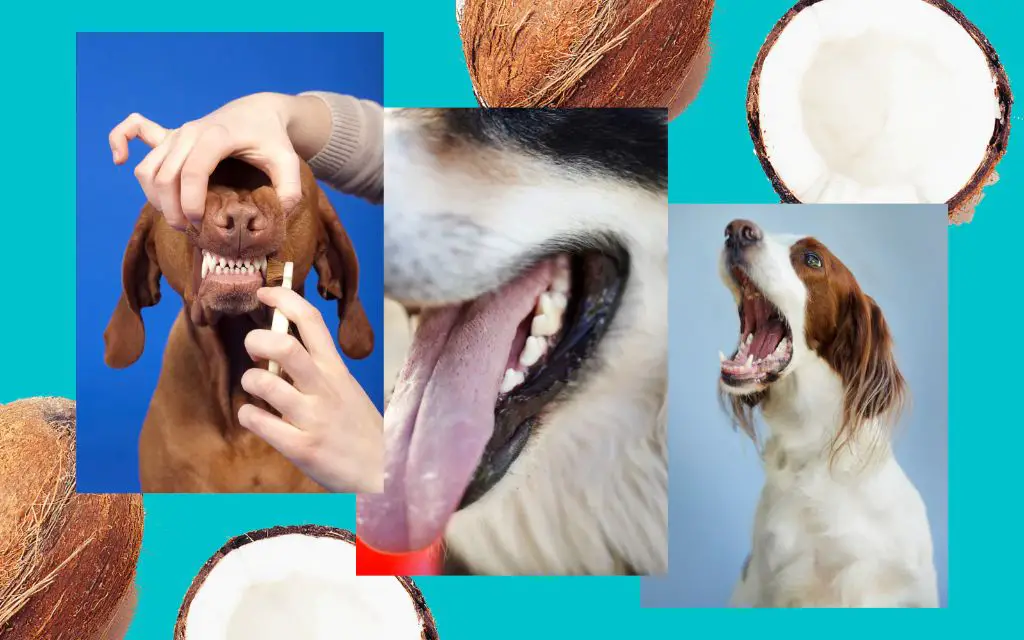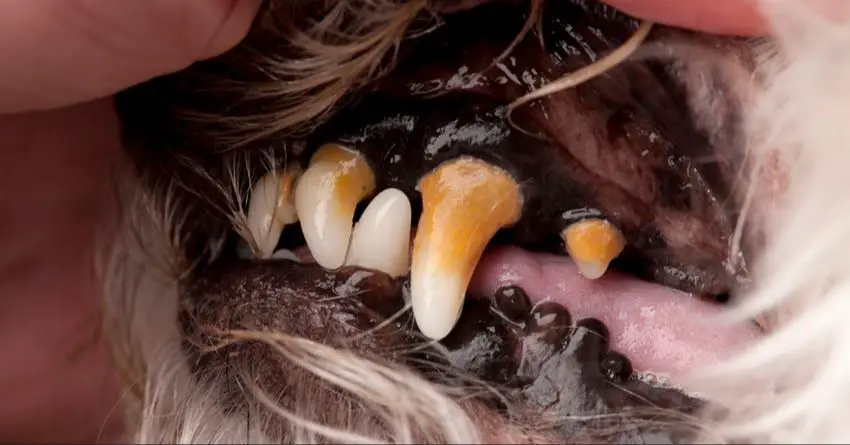The Problem of Tartar Buildup in Dogs
Plaque is a sticky film made up of food particles, saliva, and bacteria that constantly forms on the teeth. Over time, this plaque hardens into tartar which is a hard deposit that can form on dogs’ teeth. If the tartar is not properly removed from the teeth, it can lead to a number of problems.
As tartar continues to build up on the teeth, it provides an environment for more bacteria to thrive. The bacteria around the tartar can cause inflammation in the gums surrounding the teeth, leading to gingivitis and eventually periodontitis if left untreated. These gum diseases are very common in dogs and can be quite painful.
The tartar and bacteria around the gums will also start attacking the tooth itself, leading to infections or tooth decay. Severe tartar buildup will physically loosen teeth and can even cause them to fall out. Therefore, it’s critical to remove tartar regularly to avoid gum disease, infections, decay, and tooth loss in dogs.
What is Baking Soda?
Baking soda, also known as sodium bicarbonate, is a chemical compound with the formula NaHCO3. It is a mild base that has numerous household and industrial applications. Some key facts about baking soda:
– It is an alkaline white crystalline solid that dissolves in water. When dissolved in water, baking soda creates a solution with a pH higher than 7, meaning it is a basic (alkaline) substance rather than acidic.
– It has mild abrasive properties, which is why it is commonly found in cleaning products and toothpastes. The abrasiveness helps remove dirt, grease, and stains.
– Baking soda releases carbon dioxide gas when exposed to an acid or heat, which causes baked goods to ‘rise’ during cooking. This property makes it a common leavening agent in baking.
– It has natural deodorizing and freshening properties, absorbing odors rather than masking them. Many people use baking soda boxes in their refrigerator or sprinkle it on carpets to absorb unpleasant smells.
So in summary, baking soda is a versatile household product and cooking ingredient due to its alkaline properties, mild abrasiveness, deodorizing abilities, and use as a leavening agent. This makes it a popular DIY cleaning solution and potential remedy for issues like tartar buildup in dogs.

Does Baking Soda Remove Tartar?
Baking soda can help remove some tartar buildup on a dog’s teeth due to its mildly abrasive quality, but it does not actually dissolve tartar. When gently scrubbed onto a dog’s teeth, baking soda can provide a mechanical cleaning by physically scraping off some of the hardened plaque and tartar. However, unlike chemical cleaners designed for pets, baking soda does not contain any enzymes or agents that actively break down and dissolve tartar.
While using baking soda occasionally may help reduce superficial tartar, especially when combined with brushing, it cannot penetrate below the surface or fully remove large tartar deposits. Any visible improvement would likely be minor and temporary. For heavy tartar buildup, a complete professional dental cleaning under anesthesia is required. So while baking soda can be used safely in moderation, it should not be relied on as an effective way to remove significant tartar from a dog’s teeth.
How to Apply Baking Soda
Baking soda can be applied to your dog’s teeth and gums in a few simple ways:

Make a paste by mixing baking soda with a small amount of water or coconut oil. The paste should be thick but still spreadable.
Gently rub the baking soda paste onto your dog’s teeth and gums using your finger or a soft-bristled toothbrush. Make sure to fully coat the surface of each tooth.
Let the baking soda sit on the teeth for 2-3 minutes to allow time for it to work before rinsing. Be careful not to let your dog swallow large amounts.
Rinse thoroughly with water to remove all traces of baking soda. You can follow up with a dog-safe toothbrush if desired.
Start slowly at first, using baking soda 1-2 times per week. Monitor for any signs of irritation or discomfort.
Risks and Precautions
While baking soda can help remove some tartar from dogs’ teeth, you must take certain precautions:
Do not overuse baking soda, as this can erode the enamel over time. Limit applications to once or twice per week at most.
Avoid getting baking soda in your dog’s eyes or nose, as this can cause irritation. Keep your dog still and wipe only the surface of the teeth.
Monitor for signs of stomach upset, like vomiting or diarrhea, after applying baking soda. Some dogs may ingest too much while licking their teeth.
Talk to your vet if you have any concerns about the safety or effectiveness of using baking soda for your dog’s dental care.
Other Home Remedies
In addition to baking soda, there are some other home remedies that may help remove tartar from a dog’s teeth:
Coconut Oil Pulling

Coconut oil contains lauric acid which has natural antibacterial and anti-inflammatory properties. Putting a small amount of coconut oil on your finger and massaging your dog’s teeth and gums can help break down plaque and tartar over time. The coconut oil also freshens breath.
Antibacterial Gels
There are some antibacterial gels made specifically for pets that can be applied to the teeth and gums. These gels contain chlorhexidine which kills bacteria and helps prevent plaque buildup. Always follow label instructions carefully.
Enzymatic Toothpastes
Dog toothpastes containing enzymes like glucoamylase and glucose oxidase can help break down plaque and tartar. Using an enzymatic toothpaste regularly when brushing your dog’s teeth at home will help keep tartar under control.
When to See a Vet
While baking soda and other home remedies may help remove mild tartar, severe buildup often requires professional veterinary dental care. Signs that your dog needs to see a vet for a dental cleaning include:
- Large chunks of tartar on the teeth
- Extremely bad breath even after brushing
- Red, inflamed, or bleeding gums
- Loose or infected teeth
- Difficulty eating due to dental pain
- Swollen face or jaw
- Pus around teeth and gums

If you notice any of these warning signs, schedule a veterinary dental appointment right away. Leaving advanced gum disease and tooth decay untreated can lead to oral infections, tooth loss, and even systemic issues in other areas of the body.
Most vets recommend professional dental cleanings once a year or more for dogs prone to tartar buildup. The vet will scale and polish your dog’s teeth to remove tartar above and below the gumline. In severe cases of periodontal disease, tooth extractions or antibiotics may be needed. Your vet can also show you how to properly care for your dog’s teeth at home between dental cleanings.
Preventing Tartar Buildup
There are several effective ways to help prevent tartar buildup and keep your dog’s teeth clean and healthy:
Brushing Teeth
Brushing your dog’s teeth daily is the most effective way to remove plaque and prevent tartar buildup. Use a soft-bristled toothbrush and dog-safe toothpaste. Gently brush all surfaces of the teeth in a circular motion. Introduce toothbrushing slowly and make it a positive experience with praise and rewards.
Dental Chews
Giving your dog dental chews or treats daily helps scrape away plaque and tartar. Look for vet-approved options that are specifically formulated to reduce tartar buildup. Avoid hard chews that can damage teeth. Supervise your dog with any dental chew to prevent choking.
Annual Cleanings
Even with home care, most dogs need an annual veterinary dental cleaning to fully remove tartar above and below the gumline. Vets use special tools to thoroughly clean each tooth down to the root. Cleanings allow a thorough dental exam, teeth polishing, and fluoride treatment to protect teeth.
Conclusion
In summary, baking soda can be a useful home remedy for removing some tartar buildup on dogs’ teeth. When applied gently, baking soda has mild abrasive properties that can scrub away plaque and dislodge tartar. However, it has limits in its effectiveness. Baking soda is not a replacement for regular brushing and veterinary dental cleanings.
For best results, baking soda should be combined with other oral care such as toothbrushing, dental treats/chews, and professional cleanings. It can help maintain dental health between vet visits. But for dogs with severe tartar buildup, professional veterinary care is still recommended, as home remedies will likely be insufficient.
With a sensible oral care routine including brushing, chewing, and baking soda as needed, tartar can be well-managed. Pay attention to your dog’s rate of tartar accumulation and seek veterinary advice if it seems excessive. With proactive care, your dog’s teeth can stay clean and healthy.
References
[1] Viner, B. (2020, August 12). How to Remove Dog Tartar at Home. American Kennel Club. https://www.akc.org/expert-advice/health/how-to-remove-dog-tartar-at-home/
[2] Hill’s Pet Nutrition. (n.d.). Dog Dental Care 101: Tartar on Dog Teeth. https://www.hillspet.com/dog-care/teeth-ears-and-eyes/dog-dental-care-101-tartar-on-dog-teeth
[3] Banfield Pet Hospital. (2021, February 2). How to Brush Your Dog’s Teeth at Home. https://www.banfield.com/banfield-foundation/how-to-brush-dogs-teeth
[4] American Veterinary Medical Association. (2021, March 17). Home Dental Care for Dogs. https://www.avma.org/resources-tools/pet-owners/petcare/brushing-your-pets-teeth
[5] Manes, A. (2022, February 23). Does Brushing Your Dog’s Teeth Help Prevent Heart Disease? American Kennel Club. https://www.akc.org/expert-advice/health/does-brushing-your-dogs-teeth-help-prevent-heart-disease/